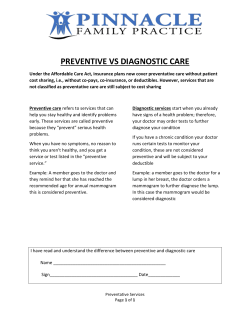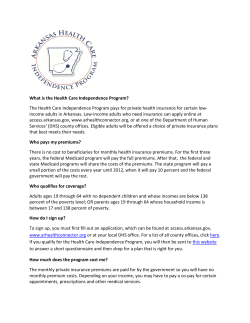
Migraine: preventive treatment
Migraine: preventive treatment You suffer from frequent and severe migraines and your doctor has spoken to you about a treatment that could help prevent them. Is this a good solution for you? This fact sheet describes what this treatment consists of. What is a preventive treatment? It is a treatment that you follow each day for several months. Its objective is to reduce the number of attacks and the severity of the pain. It does not consist of the medication you take as needed at the onset of an attack, to stop an attack. A preventive treatment is also called «prophylactic» by medical professionals. Is this treatment suitable for me? If you are in one of the following situations, it could be appropriate to try it out. – Your migraines are so intense that they prevent you from going about your daily activities: preparing meals, working, etc. – You have between four to six migraines per month, or more. We cannot foresee if a selected drug will be an effective treatment for you. You have to try it out. Roughly half of those who try a preventive do improve. In other words, they experienced only half as many attacks and sometimes even less. The attacks can sometimes be less severe. Unfortunately, even a good preventive treatment cannot get rid of migraines entirely. Are there any contraindications? Sometimes. This is why your doctor will check your medical history before prescribing a preventive treatment. – You have migraines or headaches 10 days or more per month. Are there any side effects? What does it consist of? All preventive treatments can have side effects. These vary depending on which medication was prescribed to you. Talk to your doctor about it before starting treatment. A number of medications belonging to various classes can be used for migraine prevention. Each one works in a different way. With the help of your observations, your doctor will be able to recommend the one that is best suited to your needs. 1 What can I expect from a preventive treatment? Migraine: preventive treatment CHUM – Patient Education and Awareness Program What should I do BEFORE I meet with my doctor? You should have a fairly good idea of how many attacks you have per week or per month. Your doctor will need this information to prescribe the appropriate treatment. Write down pertinent information on your calendar for a period of three months. Have it with you the next time you meet with your doctor. How long does it take before I know if the preventive treatment is working? You may have to try different medications before your know which one works best for you. Results are usually apparent three or four months after starting the medication. The dose of the medication will be increased gradually during the first month for each trial. Then, if you tolerate it well, you will continue to take it for two or three months. You can then evaluate with your doctor if you wish to continue taking it. If it isn’t suitable for you, your doctor may suggest increasing the dose or try another medication. How long do I have to follow the treatment? A preventive treatment should usually be taken for at least one year. Don’t rely on your memory! > Write down the days when you have an attack and the severity of the attack on your calendar: 1 = minor, 2 = moderate, 3 = severe > When you take a pain medication, write down the name and the day that you took it. > Write down what effect the medication had. Did you feel relief? REMEMBER You can do something about your migraines! How? By focussing on three things: – your lifestyle – a treatment against attacks – a preventive treatment, if needed USEFUL RESOURCES Headache Network Canada > headachenetwork.ca Is there a risk of addiction? No. Preventive treatments are not addictive and you will not become dependent on them. If they prove to be effective, you will want to continue following it for your own comfort, but this is not an addiction. This said, a person wanting to stop a treatment regimen should not do so abruptly. Terminating treatment should be done gradually. Therefore, you should talk to your doctor about it first. Migraine Québec > migrainequebec.com This document was prepared in collaboration with Migraine Québec The content of this document in no way replaces the recommendations and diagnoses made, or the treatment suggested by your health professional. To find out more about the CHUM www.chumontreal.qc.ca 4 005 102 Septembre 2013 2 Migraine: preventive treatment This document is protected under the Creative Commons licence established by the CHUM
© Copyright 2025





















